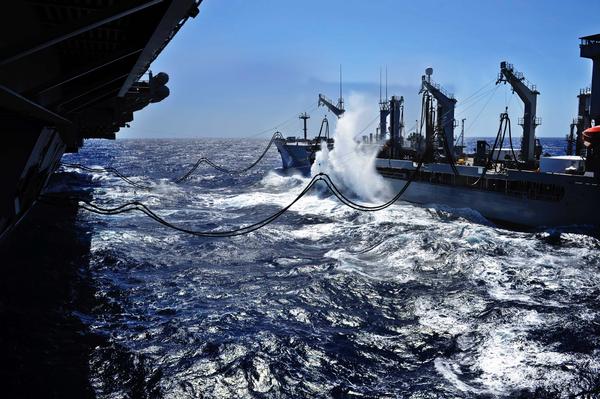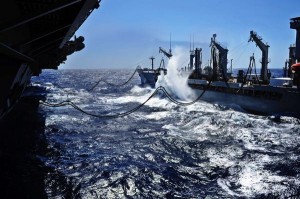Pax River’s Fuels Team Powers RIMPAC Exercise


USNS Henry J. Kaiser (T-AO 187) delivers 900,000 gallons of a 50-50 blend of advanced biofuels and traditional petroleum-based fuel to the Nimitz strike group July 17 as part of the Navy’s Great Green Fleet demonstration during the Rim of the Pacific (RIMPAC) exercise taking place in and around the Hawaiian Islands. (U.S. Navy photo)
NAVAIR’s fuels team at Naval Air Station Patuxent River is helping the Navy move closer to its goal of deploying a “fleet of ships powered by biofuels.”
The fuels team developed a 50/50 blend of camelina oil and JP-5 jet fuel for aircraft and a 50/50 blend of F-76 petroleum and algae-based biofuel to power the ship engines being used during the biennial Rim of the Pacific, or RIMPAC, exercise.
The fuel delivery is part of the Navy’s Great Green Fleet demonstration, which allows the Navy to test, evaluate and demonstrate the cross-platform utility and functionality of advanced biofuels in an operational setting.
The Green Strike Group demonstration will use 900,000 gallons of the blend during the exercise. The demonstration is a critical component of the Navy’s Test and Qualification process, said NAVAIR fuels team lead Rick Kamin. The exercise is used for approving fuels produced from renewable sources for inclusion in the Navy’s JP-5 (shipboard aviation fuel) and F-76 (marine diesel fuel) specifications, Kamin said.
Begun as an annual exercise in 1971, RIMPAC is a multinational maritime exercise that takes place in and around the Hawaiian Islands. RIMPAC 2012 began June 29 and is scheduled to run through Aug. 3. It features 22 nations, 40 surface ships, six submarines, more than 200 aircraft and 25,000 personnel.
Secretary of the Navy Ray Mabus announced five energy goals in 2009 to reduce the Department of Navy’s consumption of energy, decrease its reliance on foreign sources of oil, and significantly increase its use of alternative energy. The purpose of these energy goals is to improve the Navy’s combat capability and to increase its energy security by addressing a significant military vulnerability: dependence on foreign oil.
One of the five energy goals is to demonstrate and then deploy a “Great Green Fleet,” a carrier strike group fueled by alternative sources of energy, including nuclear power. The Great Green Fleet is named in honor of President Theodore Roosevelt’s Great White Fleet, which helped usher in America as a global power on the world stage at the beginning of the 20th century.
Biofuel was first used by non-test and evaluation pilots last September when the Blue Angels flight demonstration team used it during the PaxRiver Air Expo. The six F/A-18 jets performed their flight demonstration without any problems, an official with the team said.
For flight demonstration, the Navy requires the 50/50 camelina/JP-5 biofuel be a drop-in replacement for petroleum-based fuel; have no notable operational differences; and be able to be mixed or alternated with petroleum fuel. It also must require no changes to the Navy’s existing fuel storage or transfer infrastructure.
Source: NAVAIR Headquarters






















